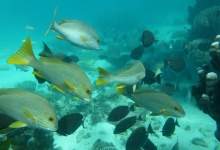

In Australia offshore oil and gas projects must co-exist harmoniously alongside some of the world’s most spectacular coral reef systems.
Ningaloo Reef system is just one such reef residing around 50km from the Exmouth sub-basin where BHP Billiton Petroleum operates the oil-producing Pyrenees and Stybarrow Floating Production Storage and Offloading Facilities (FPSO).
The Ningaloo Reef is one of the longest near shore reefs in the world and is home to 500 species of fish – including the largest aggregations of whale sharks in the world – as well as 250 species of coral.
Since oil and gas operations in the nearby Exmouth sub-basin began several years ago there have been concerns about the impact operations might have on the reef and, worse still, the devastation that could be caused by a Deepwater Horizon style oil spill.
See Also:
To be able to better mitigate potential future harm from the offshore oil and gas industry, and to be able to identify any unnatural changes in the environment BHP announced in February that it would invest AUD$2.6m, in conjunction with CSIRO, Australia’s national science agency, for a five year research project to monitor and collect data on the reef. It will also include three PhD scholarships to help support the next generation of scientists.
How well do you really know your competitors?
Access the most comprehensive Company Profiles on the market, powered by GlobalData. Save hours of research. Gain competitive edge.

Thank you!
Your download email will arrive shortly
Not ready to buy yet? Download a free sample
We are confident about the unique quality of our Company Profiles. However, we want you to make the most beneficial decision for your business, so we offer a free sample that you can download by submitting the below form
By GlobalDataThe investment is part of the company’s voluntary community contributions and follows on from a previous investment by the company into the Ningaloo Atlas Research program also designed to better understand and map the reef.
In use since 1996 the former mine site has changed beyond all recognition.
The new project will help inform any environmental decisions BHP needs to make in the future and assist it in better mitigating any potential damage its operations may have.
"We are dedicated to ensuring the knowledge on which we base our operational decisions is entrenched in science," said BHP Billiton Petroleum general manager, Doug Handyside, at the project launch in Perth. "This enables us to uphold our commitment to operate in the most environmentally responsible manner possible."
The project has only just started, with field trips taking place in the coming weeks. When completed it is hoped the research can also be used to benefit the protection of reefs in the Indian Ocean where a burgeoning offshore oil and gas industry is emerging.
Heidi Vella-Starr: How did this research programme come about?
Matt Vanderklift: CSIRO has a long history of successful collaborations with industry and conducting research at Ningaloo. When BHP approached us with their desire to support a long-term research program at Ningaloo several years ago, we quickly realised that a partnership between industry and the scientific community could provide long-term benefits for the sustainable development and conservation of the region.
HVS: What are you hoping to find through your research?
MV: We aim to provide assessments of the condition of some of the key ecological features of Ningaloo Reef, like corals and fish, and as part of this we will provide some new information about the organisms living in water deeper than diving depths, and how they change. We will also provide new information about the feeding habits and movement of some of the iconic species that inhabit the reef, like turtles.
HVS: How will the project better help the petroleum industry to understand the local reef and animal populations?
MV: Our research program will deliver annual surveys of the key fauna – such as corals and fish – of the shallow and deep waters of Ningaloo Reef. This will allow us to measure the amount of change that is normal from year to year. This will give us the sort of baseline understanding we need in order to detect when changes occur that are not part of natural variability.
We are designing our surveys to take into account the marine park and its zones, so that we can provide this information to marine park managers as well as industry; therefore we will be able to provide information to a range of stakeholders so they can decide what the most appropriate actions are.
HVS: What does the research entail?
MV: We will be doing a range of research activities divided into three main research themes; dive surveys of corals and fish for shallow reef; sonar, video and Autonomous Underwater Vehicle surveys of deeper water habitats for deep reef theme; and satellite and acoustic tagging of turtles and sharks for the tagging and tracking part of the research.
Australia has a legacy of abandoned mines which are not being rehabilitated.
HVS: What challenges are you expecting to face?
MV: There are always challenges associated with working in remote places, but we have a pretty experienced team who have been working in the area for 10 years, so we feel well equipped to deal with any challenges. This year we had cyclone Olwyn go right over the top of us while we were running a trip at Ningaloo, which really did present some challenges. It slowed us down for a couple of days, but, fortunately, we were able to continue.
HVS: How does this research project differ from the Ningaloo Atlas Research program that was also part-funded by BHP?
MV: The very successful Ningaloo atlas is a web portal designed to share information that was collated broadly from various partners. The Ningaloo Outlook project is a research project with a focus on hands-on data collection, although we will still be sharing the knowledge we gain with a wide range of stakeholders including the community and government.
HVS: Why is it important for petroleum companies to fund research, such as this, into the local environment they operate in?
MV: We all need to work together to ensure that these places are looked after in the best way possible, so we are very happy to see a major industry representative like BHP funding research for the public good.




